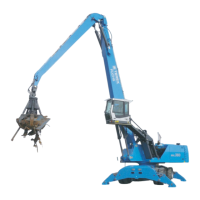4 DISPLAY AND CONTROL ELEMENTS
4.36 MHL380 D
4.6.10 Notes for use in winter
Observe the following points and instructions
in the diesel engine operating instructions for
use in winter:
4.6.10.1 Hydraulic fluid
If the machine is not used for prolonged peri-
ods at temperatures around and below freez-
ing, warm up the engine by running at medi-
um engine speed.
Warming-up time
in minutes
h Chapter 4.6.4 Warming up the loading
machine
4.6.10.2 Engine oil
The viscosity class (SAE class) of the engine
oil should be selected according to the ambi-
ent temperature at the machine’s place of
operation.
h Chapter
66H3.15 67HFuels, lubricants and cool-
ants
4.6.10.3 Coolant
Before the cold time of the year begins, the
level of antifreeze protection must be checked
and if necessary adapted to the ambient tem-
perature (for the mixing ratio see the diesel
engine manufacturer’s operating instructions).
The antifreeze level is factory-set to approx. -
35°C.
4.6.10.4 Note on options
Coolant, engine oil and hydraulic fluid can be
preheated with electrical heaters or main-
tained at temperature (supplementary heat-
ing).
The result of preheating is to shorten the cold
starting phase of the diesel engine, especially
at lower temperatures. This reduces wear on
the diesel engine and fuel consumption.
4.6.10.5 Battery
Preheating the battery makes it possible to
facilitate a cold start.
4.6.10.6 Fuel
Use only standard commercial brand diesel
fuel with a sulfur content lower than 0.05%. A
higher sulfur content will affect the oil change
intervals and service life of the engine.
h Chapter
66H3.15 67HFuels, lubricants and cool-
ants
Diesel fuel releases paraffin crystals as out-
side temperatures fall. These crystals in-
crease flow resistance in the fuel filter to such
an extent that an adequate fuel supply to the
diesel engine is no longer ensured.
If the cold-flow behavior of the diesel fuel is
not adequate or if outside temperatures are
lower than -20°C, we recommend using a fuel
filter heater.
Special diesel fuels are available for arctic
climates.
Mixing petroleum and gasoline is prohibit-
ed for safety and technical reasons (cavita-
tion affecting the fuel injection system)!
Notes
for use
in

